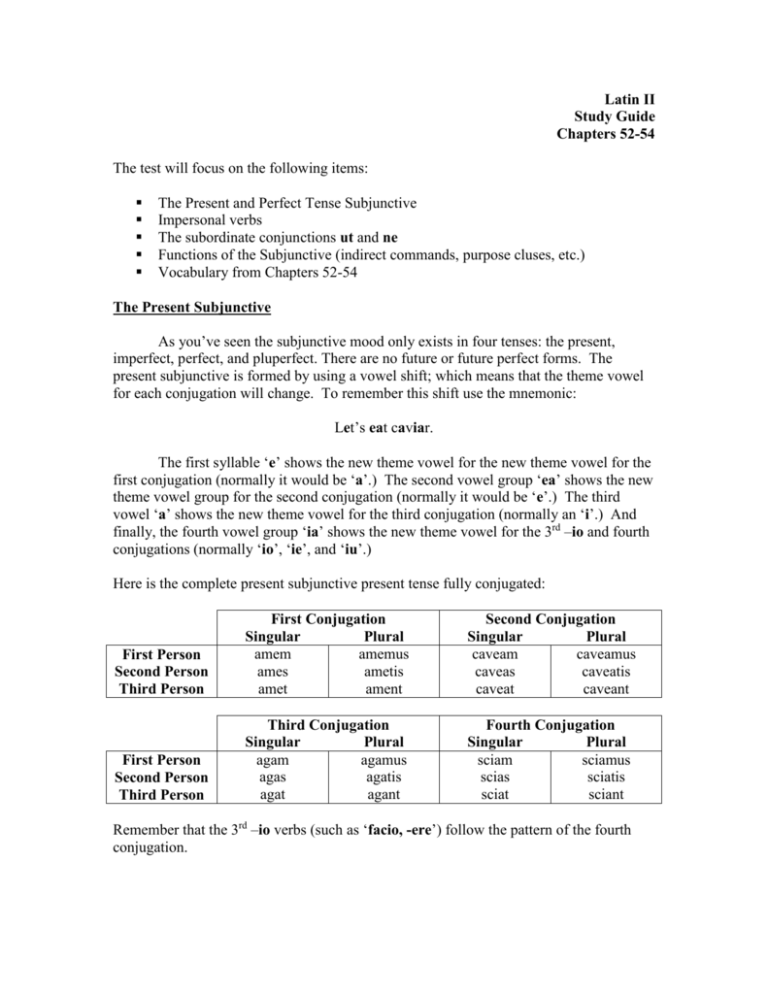Latin II - SCHOOLinSITES
advertisement

Latin II Study Guide Chapters 52-54 The test will focus on the following items: The Present and Perfect Tense Subjunctive Impersonal verbs The subordinate conjunctions ut and ne Functions of the Subjunctive (indirect commands, purpose cluses, etc.) Vocabulary from Chapters 52-54 The Present Subjunctive As you’ve seen the subjunctive mood only exists in four tenses: the present, imperfect, perfect, and pluperfect. There are no future or future perfect forms. The present subjunctive is formed by using a vowel shift; which means that the theme vowel for each conjugation will change. To remember this shift use the mnemonic: Let’s eat caviar. The first syllable ‘e’ shows the new theme vowel for the new theme vowel for the first conjugation (normally it would be ‘a’.) The second vowel group ‘ea’ shows the new theme vowel group for the second conjugation (normally it would be ‘e’.) The third vowel ‘a’ shows the new theme vowel for the third conjugation (normally an ‘i’.) And finally, the fourth vowel group ‘ia’ shows the new theme vowel for the 3rd –io and fourth conjugations (normally ‘io’, ‘ie’, and ‘iu’.) Here is the complete present subjunctive present tense fully conjugated: First Person Second Person Third Person First Conjugation Singular Plural amem amemus ames ametis amet ament Second Conjugation Singular Plural caveam caveamus caveas caveatis caveat caveant First Person Second Person Third Person Third Conjugation Singular Plural agam agamus agas agatis agat agant Fourth Conjugation Singular Plural sciam sciamus scias sciatis sciat sciant Remember that the 3rd –io verbs (such as ‘facio, -ere’) follow the pattern of the fourth conjugation. The verb sum has an irregular conjugation in the subjunctive, as you might expect: First Person Second Person Third Person Singular sim sis sit Plural simus sitis sint Passive Present Subjunctive For the passive of the present sunjunctive you merely replace the primary endings with the passive endings: First Conjugation Singular Plural amer amemur ameris amemini ametur amentur First Person Second Person Third Person Second Conjugation Singular Plural cavear caveamur cavearis caveamini caveatur caveantur Perfect Subjunctive For the active of the perfect subjunctive you simply add the endings –erim, -eris, -erit, -erimus, -eritis, -erint. to the 3rd principle part of the verb. Notice how close the resulting form is to the indicative future perfect: First Person Second Person Third Person Singular amaverim amaveris amaverit Plural amaverimus amaveritis amaverint For the passive of the perfect you combine the fourth principle part of the verb with the present subjunctive of the verb sum (which you learned above): First Person Second Person Third Person Singular amatus sim amatus sis amatus sit Plural amati simus amati sitis amati sint Impersonal Verbs Impersonal verbs are verbs that have no forms except 3rd person singular forms and infinitive forms. For this reason when listed in vocabulary entries the first principle part will be the 3rd person singular present tense active (rather than the 1st person singular present tense active) and the third principle part will be the 3rd person singular perfect tense active (rather than the 1st person singular perfect tense active) The following verbs and verbal phrases that you’ve met are impersonal: necesse est = it is necessary licet, licere, licuit = it is allowed placet, placere, placuit = it is pleasing, it was decided (that) decet, decere, decuit = it is becoming, it is fitting oportet, -ere, oportuit = it is right, it is fitting taedet, taedere, taesum est = it bores, it tires pluit, pluere, pluvit = it rains advesperascit, advesperascere, advesperacit = it gets dark lucet, lucere, luxit = it shines, it is day ningit, ningere, ninguit = it snows * grandinat, grandinare, grandinavit = it hails * The Subordinate Conjunctions ‘ut’ and ‘ne’ The subordinate conjunction ‘ut’ is a useful word that introduces several types of subjunctive clauses. Depending on context it can be translated as “that”, “in order to”, “to”, “so that”, “when” or “although”. Ancillae huc illuc concursabant ut omnia pararent. = The maids were running to and fro so that they might prepare everything. = The maids were running about to and fro in order to prepare everything. When used with a subjunctive the negative of ‘ut’ is ‘ne’, which can be translated as “so that... not” or somple as “lest”: Super limen sublata est ne laberetur. = She was carried over the threshold so that she would not stumble. = She was carried over the threshold lest she stumble. Uses of the Subjunctive There are ten uses of the subjunctive in Latin: Purpose Clauses Casual Subjunctive Circumstantial Subjunctive Indirect Commands Indirect Questions Result Clauses Hortatory Subjunctive * Jussive Subjunctive * Optative Subjunctive * Fear/Danger Clauses *







